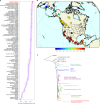Picuris Pueblo oral history and genomics reveal continuity in US Southwest
- PMID: 40307544
- PMCID: PMC12137115
- DOI: 10.1038/s41586-025-08791-9
Picuris Pueblo oral history and genomics reveal continuity in US Southwest
Abstract
Indigenous groups often encounter significant challenges when asserting ancestral claims and cultural affiliations based on oral histories, particularly in the USA where such narratives have historically been undervalued. Although ancient DNA offers a tool to complement traditional knowledge and address gaps in oral history, longstanding disregard for Indigenous sovereignty and beliefs has understandably led many Indigenous communities to distrust DNA studies1-4. Earlier research often focused on repatriation claims5-7, whereas more recent work has increasingly moved towards enhancing Tribal histories8,9. Here we present a collaborative study initiated by a federally recognized Native American tribe, the sovereign nation of Picuris Pueblo in the Northern Rio Grande region of New Mexico, USA, to address gaps in traditional knowledge and further their understanding of their population history and ancestry. We generated genomes from 16 ancient Picuris individuals and 13 present-day members of Picuris Pueblo, providing genomic data spanning the last millennium. We show genetic continuity between ancient and present-day Picuris, and more broadly with Ancestral Puebloans from Pueblo Bonito in Chaco Canyon10, 275 km to the west. This suggests a firm spatiotemporal link among these Puebloan populations of the North American Southwest. Furthermore, we see no evidence of population decline before European arrival11-13, and no Athabascan ancestry in individuals predating 1500 CE, challenging earlier migration hypotheses14-16. This work prioritizes Indigenous control of genetic data and brings together oral tradition, archaeology, ethnography and genetics.
© 2025. The Author(s).
Conflict of interest statement
Competing interests: The authors declare no competing interests.
Figures







References
Publication types
MeSH terms
Substances
Grants and funding
LinkOut - more resources
Full Text Sources

